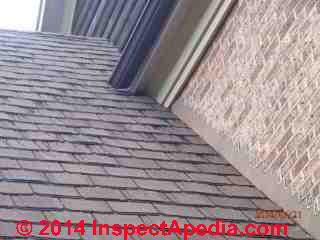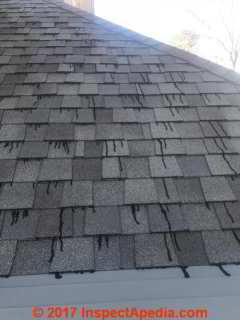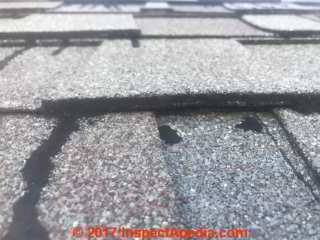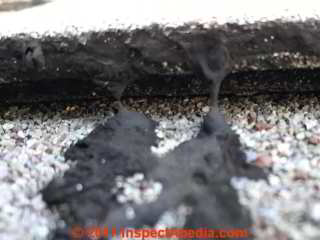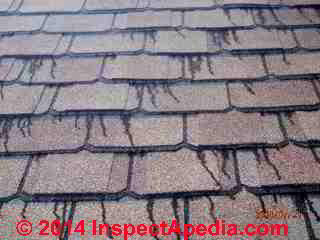 Asphalt Shingle Sealant or Laminated Tab Tarry Bleed-Out
Asphalt Shingle Sealant or Laminated Tab Tarry Bleed-Out
Black tarry run-down stains on an asphalt shingle roof: opinions, theory, diagnosis
- POST a QUESTION or COMMENT about black run-down stains on asphalt roofing
Tarry black stains on asphalt shingle roofs:
This article describes black rivulets of tar-like material observed on just a portion of the field of an asphalt shingle roof in the U.S. This appears to be bleed-down of single tab sealant. But was it factory material or something added by the roofer. Discussion, citations, opinions, diagnosis.
We discuss the possible and probable cause of these tar-stains and their effect (if any) on roof life, wind resistance.
This article also explores claims about asphalt shingle aging requirements before installation and it presents an observation methodology that can help sort out the causes of stains, irregularities, or damage & wear on roofs. Details are given for the properties of asphalt roofing shingles and the softening, melting, liquefying, and boiling point of the asphalt used in roofing products.
InspectAPedia tolerates no conflicts of interest. We have no relationship with advertisers, products, or services discussed at this website.
- Daniel Friedman, Publisher/Editor/Author - See WHO ARE WE?
Black Tarry Bleed-out from Asphalt Roof Shingle Tab Sealant
Saw this on some really heavy duty shingles on a home in the Washington D.C. Metro area. They are bleeding asphalt out.
The current owner is trying to tell us they are only 10 years old, I think they may be older but have nothing to go on. I will contribute some pictures to the cause if you can tell me a bit about these shingles.
[Click to enlarge any image]
We think these shingles may be Certainteed Grand Manor™ shingles.
There are "bleeding shingles" on all sides of the building with no rhyme or reason. Certainteed sent us a standard "canned message" to "shingles stains", and we sent them the pictures, we will see if they get back to us with anything new/better. - B.S. (Professional Home Inspector), Maryland, USA
Reply:
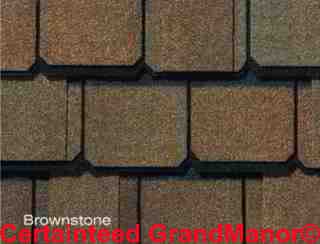 Thanks for the photos, B.S. Indeed this is an interesting case that will be helpful to other inspectors.
Thanks for the photos, B.S. Indeed this is an interesting case that will be helpful to other inspectors.
The image at left illustrates the Certainteed GrandManor™ roof shingle in the Brownstone color - which indeed looks very much like the close-up of the shingle type on the roof in your photographs.
This is from a 2014 CertainTeed product brochure. That document points out that the GrandManor™ shingle line includes "StreakFighter™ ... a special manufacturing process used to protect ... shingles from streaking and discoloration caused by airborne algae."
These shingles will indeed include a self-adhesive strip on their under-side, intended for improving the wind uplift resistance to meet wind resistance described in our citation for this product and its brochure (below).
Your original note and photos might suggest that the bleed-down black rivulets are melting shingle tab sealant but I don't think so, since they do not appear consistently across the roof.
While the manufacturing process for roof shingles can sometimes permit variation in product composition, that variation most likely across large production run quantities, not individual bundles of shingles.
If there were a product defect, more likely, given the quantity of tarry bleed-down, it would be in the sealant used to adhere the multiple plies of the shingle. Sweets Construction (cited below) points out that "The laminated tabs are firmly adhered in a special tough asphaltic cement. These fiber glass based shingles have self- sealing adhesive applied."
A web search for "Certainteed grand manor shingles sealant problems" (7/23/14) did not find other references to such complaints about shingle sealant problems though I did find a few comments about an older Owens Corning Duration™ shingle that used a continuous sealant strip that led to a concern for moisture trapping beneath shingles. That design has since changed.
Proposed Diagnosis for the Tarry Run-Down on CertainTeed GrandManor™ Shingles
In my OPINION, most likely the black tar-like run-down rivulets shown in your pictures above is not a shingle sealant-tab (for wind resistance) defect but rather a product failure involving the de-lamination of the multiple plies of the shingle or if someone attempted to repair the shingle, the subsequent bleed-out of roofing cement or even "tar" that some roofer added under the shingle tabs during original installation (or later).
This may have been done for one of two reasons:
Shingle Lamination Failure: (most likely) If the multiple-laminations of shingles were failing an on-roof repair attempting to re-glue the shingles may have been attempted to extend the roof life. My research found this homeowner comment:
We put Certainteed on our house in 1998 when we built it. We had to re shingle it in 2005 and it should of been done sooner. Everyone around us was having trouble with certainteed and their warranty was a joke. I think we got about $1200.00 for a $10,000.00 job.
They told us that we were suppose to reclue [sic, should have said Re-Glue - Ed] them with the $1200.00 and then they would stay in place. Google certained [sic, CertainTeed - Ed] and you will find out about all their lawsuits. I think it was Timberlanes [sic] that we used the 2nd time and they seem good so far. - zmracing, 1/19/2012, Subject: RE: Good Shingles / Bad Shingles, West Central MN, original source http://talk.newagtalk.com/forums/thread-view.asp? tid=280835&DisplayType=flat&setCookie=1
It's worth noting that in the same forum quoted above, other homeowners reported having no problems with CertainTeed Shingles.
As I have suggested in this and other articles on shingle failures, the many variations in shingle production, storage, installation, and individual building details can explain why a shingle product's on-roof performance varies.
Other gripes about CertainTeed shingles mention manufacturing defects but without enough detail. Most of the thread below was discussing CertainTeed Horizon shingle early failures and complaints about poor or very limited warranty coverage.
RE: Defective CertainTeed roof shingles / shingles
Just a followup. The problem is not just that the shingles didn't last the full 25 years. The problem is that the shingles have been documented to be defective from the manufacturer.
There are cases where people's shingles are falling apart after 3 years on a 25 year shingle.
This is a 100 year old company which we think unfortunately made a bad shingle and should replace the shingles on a roof. Wondering if anyone out there has had problems with this shingle and what they did about it. - posted by italiacook 8/25/05 at http://ths.gardenweb.com/forums/load/repair/msg0821243518283.html
We won't know for sure about my guess unless occasion arises to cut apart some of the roof. But it would be indicative if the owners could tell us in what month the shingles were installed.
Sometimes when there are more than workers on a roof different workers follow different procedures and we can actually map who worked where.
Maybe a novice blobbed on more cement in this area or maybe the roofer had a reason to attack just this area (such as shingles lifted and not "set" at the time of the roof installation along with an owner complaint).
And less likely,
Cold weather application: (less likely) While roofers install asphalt shingles in all temperatures, the popular saw that roofing is best performed above 40 degF. probably reflects the observation that in cold weather the self-sealing tabs may take longer to seal against wind uplift. Asphalt roof shingle tabs need an exposure of about 140 degF for 16 hours to seal properly against wind-uplift. - Cullen (1993).
Roofers will add extra cement under the tabs if roofing in cold weather, as an extra step in gluing down the tabs to avoid wind blow-off.
The reasoning is that shingles installed in cold weather may take some time for the normal adhesive to melt and set the shingle tabs - sometimes months in some climates. I've fielded complaints of wind damage in just that situation.
If too-generous blobs of cement (or perhaps in this case something too much less viscous, even "tar" if that's what the roofer had at hand) were placed under the shingle tabs they might have melted and run out over the next or future hot summers.
I think this cold-weather extra-sealant theory is less likely because a close examination of your photos seems to show that the black tarry rivulets originate not from the shingle underside but from between two laminated shingle layers.
Tar-Like Shingle Run-Out Stains Diagnostic Questions
- Did anyone ask the owner what they know about these run-stains?
- And I'd like to know where (city and state is enough) the home is located.
- And I'd like to know the direction that this bleeding slope faces
- And I'd like to know if you saw this in just this one area of the roof or on other slopes.
- Do we know the time of year that the roof was installed? The roofer may have been concerned about cold weather wind-uplift shingle damage and may have added a sealant.
- Was there a complaint of shingle layer de lamination or a record of a de lamination repair attempt?
- Does an up-close on-roof inspection of the roof show any signs of un-repaired but delaminated shingle layers?
- Has anyone asked the shingle manufacturer for an opinion about these photographs?
- Finally, if we knew the shingle brand and model I could research the matter further.
Reader follow-up: opinions about a requirement for shingle aging before installation?
The current owner doesn't know, they were that way when he got the roof.
However in asking the greater [home] inspector community, I got a response back that included the following...
"I suggest you investigate the attic first. If you have low ventilation then the shingles will essentially bake in a very hot day i.e. temperatures exceeding 100F.
If there is no air movement below the deck there is nothing to take the heat away. Shingles which are dark will absorb heat greater than lighter colour shingles and will heat up to 150 to 160 F under direct sunlight."
"Another source may be lack of curing from the plant originally. I have also seen this type of failure when the shingles had no chance to cure from the factory. In the period 2002 - 2004 if there was a lot of construction going on the shingles may not have cured from the factory. They are supposed to sit in yards for at least two months before being shipped out." - B.T. P.E. NTF: sent email query for citations 7/28/14 - Ed.
We think that the worst of the bleeding shingles were added "about" 10 years ago.
And that would line up with what the other group said. In any case we have strongly suggested that they get a formal "roof inspection" by a reputable roofer and see if we can get some more details.
These are really really heavy laminated 40-50 year shingles, and I think that the 'goo' between the laminations, close to your idea, never 'set' properly from the factory so when applied and got really HOT (attics around here can get to 150-160) they bleed. In any case, it is not "proper" and could/will affect life and more importantly, resale, so the current seller needs to 'address' this with my buyer.
Reply: patterns of of Asphalt Shingle bleed-down are diagnostic. Comments on other hypotheses:
Interesting. I'm surprised about the curing claim and will research it.
Attic temperatures & "baking shingles": About baking shingles suggested by B.T., it's hard to explain how rather uniform heating on a given roof slope produces asphalt or tar leakage only at some shingles if all were (most likely) produced in the same production run and arrived on the same pallet.
"Someone repaired a section of the roof": I'd caution that if the bleeding shingles were a patch or addition or repair on an older roof, the roofer may indeed have added extra sealant - but as the shingles in your photos look identical to their surrounding, non-bleeding neighbors this is a confounding theory.
I asked about the bleed-out pattern on the roof because it would be odd to find just a single bundle or two of asphalt shingles that were "not cured" while the rest of the roof shows none of this problem. That's a reason to think more carefully about this pattern.
Tar or other low-viscosity shingle tab add-on sealant? Also the thin-ness of the bleed out looks a lot like roofing tar to me.
It is certainly true that asphalt roofing products lose volatiles and become more brittle over time - we have published both explanation and research on this normal aging phenomenon. It would not explain the initial bleed-out we are discussing.
"Singles need curing time in the yard": About sitting in the yard, I don't want to ruffle feathers, so if you're willing you could ask B.T. for a citation on the "sit in yard" requirement - that would be valuable information to have. My own research on this question is presented just below.
Questioning the Claim of Required In-Storage Shingle Aging or Curing Before Installation Requirement Research
I (DF) researched asphalt shingle curing time for both scholarly research and manufacturer instructions but I was unable to find support for this view.
I've found a few references to "shingle curing" mostly relating (incorrectly) to the initial shingle granule loss on roofs. That claim is mistaken. The initial granule loss is the wash-down of poorly-adhered granules on shingles as delivered from the factory, appearing when the roof is new and washing down at the first few rainstorms. Granules are sprinkled on then rolled into the hot asphalt shingles - some of the top-most granules simply do not reach enough asphalt to bond firmly.
Curing is also discussed (as drying time) for some roof coating products.
"Curing" is also used as a synonym for normal asphalt shingle aging, such as in the Canadian Roofing Contractors publication I cite below. (In my opinion this article also contains an error when it claims that cracks in shingles do not affect their service life - this is certainly not true in a freezing climate).
Curing is also discussed by GAF in their application manual but NOT as asphalt shingle curing but rather as the curing of a substrate, such as concrete. The company does not cite a requirement for asphalt shingle post-manufacturing curing before use.
Nothing in the WARRANTIES for ROOF SHINGLES that I have reviewed cites a requirement for a shingle storage-curing time. - Bennett (2008), Behrdahl (2008).
Asphalt Shingle On-Roof Temperatures vs. Asphalt Shingle Manufacturing Temperatures
Details about temperatures of asphalt shingle manufacture & on-roof temperatures are
at ASPHALT SHINGLE TEMPERATURES
Excerpts from that article are just below.
The manufacturing temperatures of asphalt shingles need to be high enough to permit the asphalt to penetrate the paper or fiberglass substrate, making them likely to be closer to the boiling (say 400-500° F) than the softening point 140° F to 205° F.
Indeed the manufacturers would not enjoy using asphalt at temperatures above 400° C (752° F) since that's its auto-ignition temperature.
But the asphalt does have to be hot enough to flow into the shingle substrate. (The flash point for slow-curing liquid asphalt is around 150-225° F while an example MSDS for asphalt shingles gives a flash point of greater than 500° F. ) - IKO Production, Inc. (2012)
Similarly, TAMKO® asphalt shingle MSDS information gives the melting point of their asphalt shingles as > 200°F - well above normal on-roof temperatures. - TAMKO Shingle Product (2011)
Research on shingle durability tests asphalt shingles at temperatures typically up to a maximum of 160° F - well below the temperatures that occur during manufacture of the product.
At ASPHALT SHINGLE INSTALLATION we discuss shingle installation temperatures
and at BLISTERS on ASPHALT SHINGLES we discuss shingle manufacturing temperatures as part of the long debate about the blisters found on some new asphalt shingles. The blister topic convincingly argues that those blisters are a manufacturing artifact
... the formation of gas blisters that made clear that such temperatures are not reached in-situ on a roof.
Reader Follow-up: CertainTeed Manufacturer Suggests Product Defect in GrandManor™ Shingles
I contacted CertainTeed and sent them a picture; this was their response:
... Thank you for sending a picture. That looks more like a defect. Feel free to call our roofing warranty department to start a claim. (800) 345-1145. ... - CertainTeed email to B.S. / W.S. July 2014
I will be forwarding the contact information to the listing agent for the property, to suggest the owner contact CertainTeed for the possibility of a warranty replacement. - W.S.
Reply:
Thanks W.S. It is curious that the product defect shows up in the pattern that it does.
Typically shingles are produced in such large quantities that a product defect in a production run would show up in all of the shingles in a given pallet of bundles of shingles and so would appear more consistently across a roof, perhaps varying by slope, pitch, sun exposure, color or other site variables but not so much varying within a given roof slope.
Perhaps the product defect is one we've been documenting - that the shingles were delaminating and that someone tried an on-roof repair to "glue back down" the loosened plies.
Do keep us posted - working together we're smarter than any individual.
Field Report: more Certainteed™ Asphalt Shingle Sealant Bleed-Down on an Alabama Roof
I have these same brand Shingles and they are doing the same in Alabama weather.
Certainteed tried to pawn it off on there class action but it isn’t covered under the suit.
$25,000 in shingles,$20,000 on install,and a set of $5500 gutter guards ruined.
I’m not to happy. Will post a picture shortly. This is a “lifetime” HD shingle installed in December 2005.
[Click to enlarge any image]
Reply:
Posting photos of your shingles plus any history you can give will be helpful.
Reader follow-up:
Posting photos, shown here.
(mod) said:
Thank you for posting the photos, Drew, we'll keep your examples in this article series as that may assist other readers.
In my OPINION there are several questions about this asphalt melt-down on the roof:
- The first photo in Mr. Sharpe's set shows that the tarry bleed-down on the roof is occurring specifically where the topmost laminated shingle layer is in place on these shingles. That's a very specific indicator.
- The last photo from Mr. Sharpe shows tarry extract exuded from the very edge of the shingle, suggesting that the asphalt loss may not be simply shingle tab sealant but rather loss of asphalt from the asphalt-impregnated body of the shingle itself.
That might be due to a formulation error when the shingles were manufactured, and that might also affect the remaining roof life. - Does this tarry shingle bleed-out indicate conditions that have reduced the remaining roof life to less than normal or less than the shingle warranty period?
- Is this only a cosmetic defect?
- Is this only a manufacturing defect or are there other factors involved.
- Has this specific tarry bleed-down on asphalt shingles appeared with other shingles by other manufacturers than Certainteed?
Asphalt Roof Shingle Bleed-out, Sealant, Wind-Resistance Research Citations
- ASTM D3161-81 Standard Test Method of Wind Resistance for Asphalt Shingles. Originally published 1972.
- Berdahl, Paul, Hashem Akbari, Ronnen Levinson, and William A. Miller. "Weathering of roofing materials–an overview." Construction and Building Materials 22, no. 4 (2008): 423-433. Abstract
An overview of several aspects of the weathering of roofing materials is presented. Degradation of materials initiated by ultraviolet radiation is discussed for plastics used in roofing, as well as wood and asphalt. Elevated temperatures accelerate many deleterious chemical reactions and hasten diffusion of material components.
. Effects of moisture include decay of wood, acceleration of corrosion of metals, staining of clay, and freeze–thaw damage. Soiling of roofing materials causes objectionable stains and reduces the solar reflectance of reflective materials. (Soiling of non-reflective materials can also increase solar reflectance.) Soiling can be attributed to biological growth (e.g., cyanobacteria, fungi, algae), deposits of organic and mineral particles, and to the accumulation of fly ash, hydrocarbons and soot from combustion. - "CertainTeed GrandManor™ Luxury Shingles", CertainTeed Corporation, (2014) product brochure. CertainTeed Corporation, Saint-Globain, Tel: 800-233-8990, Website: certainteed.com Retrieved 2/23/2014, original source: https://www.certainteed.com/resources/GrandManorBroch.pdf. This brochure describes fiber glass based shingles with randomly applied tabs, "virtual five layer coverage" when applied, 425 lbs. per square. Among the product specifications are wind resistance, UL certified to meet ASTM D3018 Type 1 and ASTM D3131, lass F, 110 mph wind resistance.
- "Technical Data Sheet, Grand Manor® Shingles", Sweets Construction, retrieved 7/23/14, original source: https://sweets.construction.com/swts_content_files/28175/523953.pdf, Quoting:
CertainTeed GrandManor™ shingle warranty:
Grand Manor carries a lifetime limited transferable warranty against manufacturing defects for the original homeowner. In addition, Grand Manor also carries 10-year SureStart™ Protection. For specific warranty details and limitations, refer to the warranty itself (available from the local supplier, roofing contractor or on-line at www.certainteed.com ) - Cullen, WILLIAM C. "Research and performance experience of asphalt Shingles." In 10th Conference on Roofing Technology, vol. 7. 1993. [Cullen writes under the aegis of the NRCA - Ed.]
- Hanz, Andrew, Enad Mahmoud, and Hussain Bahia. "Impacts of WMA production temperatures on binder aging and mixture flow number." Journal of the Association of Asphalt Paving Technologists 80 (2011). Abstract:
- Halunen, Clayton, Quoting: Posted by
Clayton Halunen
(halunen@halunenlaw.com) on
Wed, Nov 9, 05 at 11:58
My law firm is currently investigating CertainTeed shingles based upon complaints of deterioration and curling we have received throughout the country.
We will seek to have CertainTeed reimburse customers for the cost of replacing their roofs. If you have CertainTeed shingles that have failed, please contact me at (612) 605-4098 or: halunen@halunenlaw.com. - retrieved 2/23/14, original source: http://ths.gardenweb.com/forums/load/repair/msg0821243518283.html
[Contacted with request for product failure details 7/23/14] - IKO Production, Inc., "MSDS #1810 - Granular Bituminous Shingle Material", IKO Production, Inc., 120 Hay Road, Wilmington DE 19809, USA, retrieved 7/22/14, original source: http://www.canroof.com/publication/ 1810-msds-granular-bituminous-shingle-material/wppa_open/
- Newcomb, David E., Mary Stroup-Gardiner, Brian M. Weikle, and Andrew Drescher. "Properties of dense-graded and stone-mastic asphalt mixtures containing roofing shingles." ASTM SPECIAL TECHNICAL PUBLICATION 1193 (1993): 145-145.
- Noone, MICHAEL J., and W. KENT Blanchard. "Asphalt Shingles–A Century of Success and Improvement." In Proceedings of the 10th Conference on Roofing Technology, pp. 23-33. 1993.
- Shaw, DONALD E. "ARMA’s New Approach for Evaluation of Asphalt Shingle Wind Resistance." In Proceedings of the Third International Symposium on Roofing Technology, p. 216. 1991.
- TAMKO Shingle Products, Material Safety Data Sheet (MSDS) -T01A2011, Tamko Shingle Products, TAMKO Building Products, Inc., PO Box 1404, Joplin MO 64802, Tel: 1-417-624-6644, retrieved 7/22/2014, original source http://www.tamko.com/docs/documents-msds/ TAMKO%C2%AE_Asphalt_Shingle_MSDS.pdf?sfvrsn=0
- http://birdstairs.ca/files/Guide%20to%20Ashphalt%20Roofing%20Shingles%20and%20Installers.pdf
- http://www.gaf.com/Commercial_Roofing_Systems/GAFGLAS/GAF_GAFGLAS_RUBEROID_ Application_and_Specification_Manual_without_CAD_Details_315_pages_2MB.pdf
- ASTM C 1313-00 Standard Specification for Sheet Radiant Barriers for Building Construction
Applications - ASTM C 1158-01 Standard Practice for use and Installation of Radiant Barrier Systems (RBS)
in Building Construction
...
Reader Comments, Questions & Answers About The Article Above
Below you will find questions and answers previously posted on this page at its page bottom reader comment box.
Reader Q&A - also see RECOMMENDED ARTICLES & FAQs
On 2020-08-22 by (mod) - severe sealant run-out at CertainTeed asphalt shingle roof
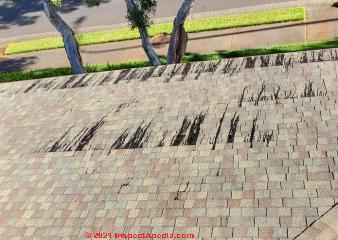 Les
Les
You'd think that a photo would be sufficient, but if you go ahead and remove a sample of damaged roofing for analysis by the manufacturer, certainly you'd not sit with the roof open to the weather.
You'd patch the cut-out area with any shingle type that can be cut and installed to fit. That's a trivial and easy repair well within the ability of any roofing contractor.
Incidentally the amount of black tarry runout is so extensive that I'm left wondering if when the roof was applied someone added a lot of additional mastic adhesive between some of the shingle plies.
Do you have any photos and such details of the roof during its installation?
Let us know what CertainTeed tells you as that will certainliy help other readers with roof shingle bleed issue diagnosis.
On 2020-08-20 by Les Tells
Saw this a few years after install in January 2006. Finally decided I let it go too long and it's really looking bad. I can see it on google maps. What the heck is causing this? It's only on the South facing side of my roof.
There is very little of it on the East facing side and None on the West side. There is no North side of this roof as that's the side that this section of the roof attaches to the rest of the house.
This seems like a nightmare to deal with.
My warranty packet specifies that I need to remove a 20" X 40" section and ship it to CertainTeed.
Shipping from Honolulu, HI to Montgomeryville, PA and waiting for them to evaluate will take some time.
While my roof sits with a 20" X 40" section of removed shingles?
...
Continue reading at ASPHALT SHINGLE TEMPERATURES or select a topic from the closely-related articles below, or see the complete ARTICLE INDEX.
Or see these
Roof Stain Diagnosis, Repair, Prevention Articles
- ASPHALT SHINGLE BLISTER RASH CAUSE
- ROOF SEALANTS & MASTICS
- STAIN DIAGNOSIS on ROOFS - home
- TEST LABS - ROOF SHINGLE
- TOBACCO JUICING SHINGLE STAINS
Suggested citation for this web page
ASPHALT SHINGLE TARRY BLEED at InspectApedia.com - online encyclopedia of building & environmental inspection, testing, diagnosis, repair, & problem prevention advice.
Or see this
INDEX to RELATED ARTICLES: ARTICLE INDEX to BUILDING ROOFING
Or use the SEARCH BOX found below to Ask a Question or Search InspectApedia
Ask a Question or Search InspectApedia
Try the search box just below, or if you prefer, post a question or comment in the Comments box below and we will respond promptly.
Search the InspectApedia website
Note: appearance of your Comment below may be delayed: if your comment contains an image, photograph, web link, or text that looks to the software as if it might be a web link, your posting will appear after it has been approved by a moderator. Apologies for the delay.
Only one image can be added per comment but you can post as many comments, and therefore images, as you like.
You will not receive a notification when a response to your question has been posted.
Please bookmark this page to make it easy for you to check back for our response.
IF above you see "Comment Form is loading comments..." then COMMENT BOX - countable.ca / bawkbox.com IS NOT WORKING.
In any case you are welcome to send an email directly to us at InspectApedia.com at editor@inspectApedia.com
We'll reply to you directly. Please help us help you by noting, in your email, the URL of the InspectApedia page where you wanted to comment.
Citations & References
In addition to any citations in the article above, a full list is available on request.
- Akbari, Hashem, P. Berdahl, R. Levinson, R. Wiel, A. Desjarlais, W. Miller, N. Jenkins, A. Rosenfeld, and C. Scruton. "Cool colored materials for roofs." In Proceedings of the ACEEE 2004 Summer Study on Energy Efficiency in Buildings, vol. 1, pp. 1-12. 2004.
- ASTM D3161-81 Standard Test Method of Wind Resistance for Asphalt Shingles. Orignially published 1972.
- Berdahl, Paul, Hashem Akbari, Ronnen Levinson, and William A. Miller. "Weathering of roofing materials–an overview." Construction and Building Materials 22, no. 4 (2008): 423-433. Abstract
An overview of several aspects of the weathering of roofing materials is presented. Degradation of materials initiated by ultraviolet radiation is discussed for plastics used in roofing, as well as wood and asphalt. Elevated temperatures accelerate many deleterious chemical reactions and hasten diffusion of material components. Effects of moisture include decay of wood, acceleration of corrosion of metals, staining of clay, and freeze–thaw damage. Soiling of roofing materials causes objectionable stains and reduces the solar reflectance of reflective materials. (Soiling of non-reflective materials can also increase solar reflectance.) Soiling can be attributed to biological growth (e.g., cyanobacteria, fungi, algae), deposits of organic and mineral particles, and to the accumulation of fly ash, hydrocarbons and soot from combustion. - Bennert, Thomas, Ali Maher, and Robert Sauber. "Influence of production temperature and aggregate moisture content on the initial performance of warm-mix asphalt." Transportation Research Record: Journal of the Transportation Research Board 2208, no. 1 (2011): 97-107.
- "CertainTeed GrandManor™ Luxury Shingles", CertainTeed Corporation, (2014) product brochure. CertainTeed Corporation, Saint-Globain, Tel: 800-233-8990, Website: certainteed.com Retrieved 2/23/2014, original source: https://www.certainteed.com/resources/GrandManorBroch.pdf. This brochure describes fiber glass based shingles with randomly applied tabs, "virtual five layer coverage" when applied, 425 lbs. per square. Among the product specifications are wind resistance, UL certified to meet ASTM D3018 Type 1 and ASTM D3131, lass F, 110 mph wind resistanc.
- "Technical Data Sheet, Grand Manor® Shingles", Sweets Construction, retrieved 7/23/14, original source: https://sweets.construction.com/swts_content_files/28175/523953.pdf, Quoting:
CertainTeed GrandManor™ shingle warranty:
Grand Manor carries a lifetime limited transferable warr anty against manufacturing defects for the original homeowner. In addition, Grand Manor also carries 10-year SureStart™ Protection. For specific warranty details and limitations, refer to the warranty itself (available from the local supplier, roofing contractor or on-line at www.certainteed.com ) - Corbett, Luke W., and Rolf Urban. "Asphalt and bitumen." Ullmann's Encyclopedia of Industrial Chemistry (1985).
- Cullen, WILLIAM C. "Research and performance experience of asphalt Shingles." In 10th Conference on Roofing Technology, vol. 7. 1993. [Cullen writes under the aegis of the NRCA - Ed.]
- Falchetto, Augusto Cannone, Mihai O. Marasteanu, and Herve Di Benedetto. "Analogical based approach to forward and inverse problems for asphalt materials characterization at low temperatures." Journal of the Association of Asphalt Paving Technologists 80 (2011).
- Hanz, Andrew, Enad Mahmoud, and Hussain Bahia. "Impacts of WMA production temperatures on binder aging and mixture flow number." Journal of the Association of Asphalt Paving Technologists 80 (2011). Abstract:
Due to the potential to realize environmental benefits related to lower production temperatures, implementation of Warm Mix Asphalt (WMA) has generated interest at state and national levels. However, from the standpoint of sustainability, WMA must meet or exceed the performance of conventional HMA. Consequently, successful implementation requires mix design procedures that consider the impacts of reduced production temperatures on material properties and the overall performance of the mixture. In this study the effects of reduced aging temperatures were evaluated through characterization of asphalt binder properties after short-term aging at standard and lowered RTFO temperatures and long-term aging under standard PAV conditions. Materials tested included two asphalt binder sources and three WMA additive types. It was found that reduced aging temperatures have a significant influence on the high temperature performance of binders, but a negligible effect on intermediate and low temperature rheological properties evaluated after PAV aging. Results were modeled based on the procedures provided in NCHRP 9- 43 to define the maximum allowable reductions in production temperature for the materials tested in this study. Preliminary findings indicate that the predicted temperature reductions for the FHWA aging model and the laboratory generated data set differed by 9 C, indicating that refinement of the model through evaluation of additional binder sources, grades, and WMA additives is needed. In addition, the need for establishing minimum production temperatures for WMA to ensure adequate field performance is emphasized, due to the observation of similar sensitivity to aging temperature in mixture performance testing. - Halunen, Clayton, Quoting: Posted by
Clayton Halunen
(halunen@halunenlaw.com) on
Wed, Nov 9, 05 at 11:58
My law firm is currently investigating CertainTeed shingles based upon complaints of deterioration and curling we have received throughout the country. We will seek to have CertainTeed reimburse customers for the cost of replacing their roofs. If you have CertainTeed shingles that have failed, please contact me at (612) 605-4098 or: halunen@halunenlaw.com. - retrieved 2/23/14, original source: http://ths.gardenweb.com/forums/load/repair/msg0821243518283.html
[Contacted with request for product failure details 7/23/14] - Inchem, "Asphalt, Bitumen, Petroleum Bitumen" properties, CAS# 8052-42-4, UN# 1999", retrieved 7/22/2014, original source http://www.inchem.org/documents/icsc/icsc/eics0612.htm
- IKO Production, Inc., "MSDS #1810 - Granular Bituminous Shingle Material", IKO Production, Inc., 120 Hay Road, Wilmington DE 19809, USA, retrieved 7/22/14, original source: http://www.canroof.com/publication/ 1810-msds-granular-bituminous-shingle-material/wppa_open/
- Jones, David S.J., and Peter P.Pujado (Editors) (2006). Handbook of Petroleum Processing, First Edition. Springer. ISBN 1-4020-2819-9.
- Newcomb, David E., Mary Stroup-Gardiner, Brian M. Weikle, and Andrew Drescher. "Properties of dense-graded and stone-mastic asphalt mixtures containing roofing shingles." ASTM SPECIAL TECHNICAL PUBLICATION 1193 (1993): 145-145.
- Noone, MICHAEL J., and W. KENT Blanchard. "Asphalt Shingles–A Century of Success and Improvement." In Proceedings of the 10th Conference on Roofing Technology, pp. 23-33. 1993.
- Parker, Danny S., and John R. Sherwin. "Comparative summer attic thermal performance of six roof constructions." TRANSACTIONS-AMERICAN SOCIETY OF HEATING REFRIGERATING AND AIR CONDITIONING ENGINEERS 104 (1998): 1084-1092.
- Shaw, DONALD E. "ARMA’s New Approach for Evaluation of Asphalt Shingle Wind Resistance." In Proceedings of the Third International Symposium on Roofing Technology, p. 216. 1991.
- TAMKO Shingle Products, Material Safety Data Sheet (MSDS) -T01A2011, Tamko Shingle Products, TAMKO Building Products, Inc., PO Box 1404, Joplin MO 64802, Tel: 1-417-624-6644, retrieved 7/22/2014, original source http://www.tamko.com/docs/documents-msds/ TAMKO%C2%AE_Asphalt_Shingle_MSDS.pdf?sfvrsn=0
- Terrenzio, LOUIS A., JOHN W. Harrison, DAVTO A. Nester, and M. L. Shiao. "Natural v. artificial aging: use of diffusion theory to model asphalt and fiberglass-reinforced shingle performance." In Proceedings of the Fourth International Symposium on Roofing Technology. 1997.
- U.S. EPA, "Asphalt Category Analysis and Hazard Characterization", Submitted to the US EPA by the American Petroleum Institute Petroleum HPV Testing Group (July 2009), retrieved 7/22/14, original source: http://www.epa.gov/hpv/pubs/summaries/asphlcat/c14901ad2.pdf
- http://birdstairs.ca/files/Guide%20to%20Ashphalt%20Roofing%20Shingles%20and%20Installers.pdf
- http://www.gaf.com/Commercial_Roofing_Systems/GAFGLAS/GAF_GAFGLAS_RUBEROID_ Application_and_Specification_Manual_without_CAD_Details_315_pages_2MB.pdf
- "The Effect of Radiant Barriers in an Attic Application on Exterior Roofing Materials, Technical Bulletin 103", Reflective Insulation Manufacturers Association International (RIMA-I)
PO Box 4110
Olathe, KS 66063
Toll-Free: (800) 279-4123
Phone/Fax: (913) 730-8869, Retrieved 7/22/2014, original source http://www.rimainternational.org/index.php/technical/tb-index/tb103/
Excerpted Quote:- The effect of attic radiant barriers on the temperatures of roofing materials is the subject of a recently completed RIMA-I study. Dark roofing material (shingles) can absorb as much as 95% of incident solar radiation and, as a result, will increase in temperature above the surrounding air temperature. The temperature reached by a roof in the heat of the day depends partly on the amount of heat transferred downward into the attic and conditioned space. The installation of an attic radiant barrier significantly decreases the amount of heat transferred in the downward direction with the result that the roof material temperatures will increase. The questions addressed by this bulletin are the magnitude of the temperature increase and the effect of the temperature increase on material warranties. The results of this study are:
- Roof shingle temperature increases due to attic radiant barriers are 2 to 5 degrees Fahrenheit.
- Roofing material warranties are not affected by the installation of attic radiant barriers.
- ASTM C 1313-00 Standard Specification for Sheet Radiant Barriers for Building Construction
Applications - ASTM C 1158-01 Standard Practice for use and Installation of Radiant Barrier Systems (RBS)
in Building Construction - Jim Todd, provided photographs and description of shingle blister rash on a four year old Atlas Chalet™ shingle roof. 9 July 2009.
- Problems in Roofing Design, B. Harrison McCampbell, Butterworth Heineman, 1991 ISBN 0-7506-9162-X (available used)
- Asphalt Roofing Residential Manual from ARMA the Asphalt Roofing Manufacturers Association Website https://www.asphaltroofing.org/product/residential-asphalt-roofing-manual/ ,
- Building Pathology, Deterioration, Diagnostics, and Intervention, Samuel Y. Harris, P.E., AIA, Esq., ISBN 0-471-33172-4, John Wiley & Sons, 2001 [General building science-DF] ISBN-10: 0471331724 ISBN-13: 978-0471331728
- Building Pathology: Principles and Practice, David Watt, Wiley-Blackwell; 2 edition (March 7, 2008) ISBN-10: 1405161035 ISBN-13: 978-1405161039
- Our recommended books about building & mechanical systems design, inspection, problem diagnosis, and repair, and about indoor environment and IAQ testing, diagnosis, and cleanup are at the InspectAPedia Bookstore. Also see our Book Reviews - InspectAPedia.
- In addition to citations & references found in this article, see the research citations given at the end of the related articles found at our suggested
CONTINUE READING or RECOMMENDED ARTICLES.
- Carson, Dunlop & Associates Ltd., 120 Carlton Street Suite 407, Toronto ON M5A 4K2. Tel: (416) 964-9415 1-800-268-7070 Email: info@carsondunlop.com. Alan Carson is a past president of ASHI, the American Society of Home Inspectors.
Thanks to Alan Carson and Bob Dunlop, for permission for InspectAPedia to use text excerpts from The HOME REFERENCE BOOK - the Encyclopedia of Homes and to use illustrations from The ILLUSTRATED HOME .
Carson Dunlop Associates provides extensive home inspection education and report writing material. In gratitude we provide links to tsome Carson Dunlop Associates products and services.


